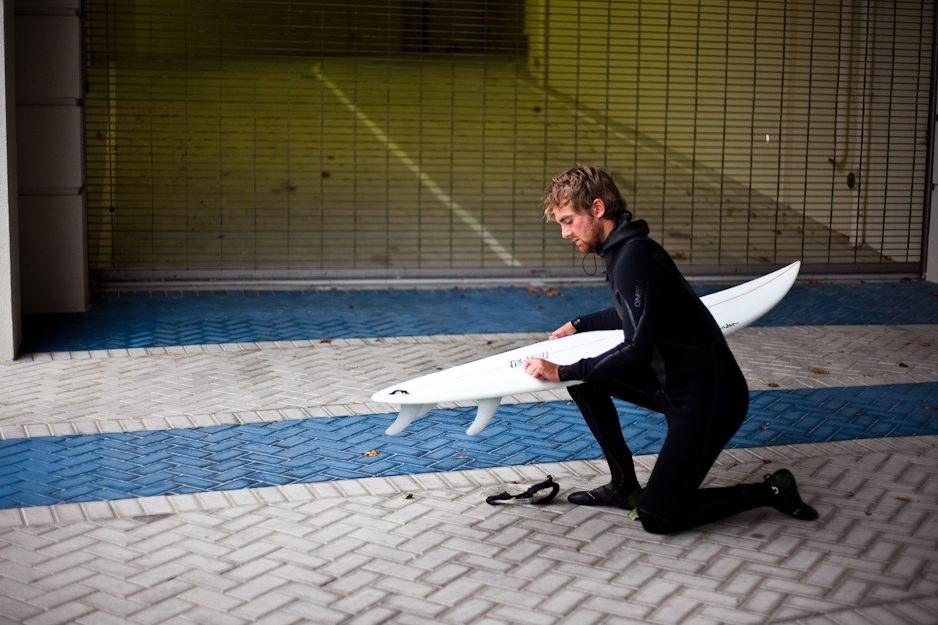
Waxing the surfboard: the grandaddy of all surf rituals. Tyler Vaughan demonstrates. Photo: Ryan Struck.
The late anthropologist Victor Turner once remarked that rituals – formal, invariant, repetitive behaviors usually performed to ensure particular outcomes – are an essential and universal human trait. Whether or not this is true, the performance of rituals, either in religious or secular settings, does indeed seem to be something to which so many of us are dedicated. From the profane (like tailgating parties before football games) to the sacred (celebrating the Catholic Mass or burning incense at the shrine of the Buddha), ritual undoubtedly plays an important role in human life.
In fact, our lives are so filled with our own personal little rituals that sometimes we might wonder how we get by without them. “Personal little rituals” are what I like to call little exercises performed over and over that, while not necessarily carrying the same perceived efficacy of, say, the Catholic transubstantiation, nonetheless give us comfort, confidence, or help us deal with difficult situations. As a college student, for example, my dad used to burn soda crackers (as an offering to the gods) the night before taking his exams.
Rituals, of course, even extend to the realm of surfing; in fact, they’ve found fertile ground there. A friend of mine always performs a particular stretch before paddling out. And it always seems to be done in a precise sequence: after he’s put on his hood and before he’s attached his leash. While he may not necessarily conclude he is engaging in ritual, the sheer repetitive nature of the stretch (performed with particular exactitude before every go out), and the importance with which he apparently imbues the act (“Hey, man, I gotta stretch or else I’ll pull my back out”), seems to qualify it as a genuine secular ritual. There are myriad others, as well. Dane Larson, who writes a surf column, has documented a number of them, from the surfer who applies wax to his palms before every go out, to the guy who allows himself to pee in his wetsuit only after his catches his first wave. Of course, for Larson, the “granddaddy of all surfing rituals” involves waxing the surfboard.
Wax provides a crucial connection between rider and board. Indeed, as recently noted by Chris Mauro in Surfer Magazine, the mystique of waxing a surfboard is “like a little Zen ritual.” Watch a surfer wax their board, and you’re likely to witness a practice that is both methodical and highly personal. Regardless of how much wax I already have on my board, I will always rub more on prior to going for a surf. Always. It may be a superficial amount, but somehow it offers a strange confidence that goes well beyond simple traction.
My own personal surf ritual takes place after a surf session, and involves the ingestion of warm infusions of Ilex paraguaneinsis. Before anyone gets the wrong idea, this strange sounding term is simply the scientific name for yerba maté, the famous South American tea. Maté is pretty well known in the United States these days, so the term is likely known to most of my readers – perhaps some have even tried it. For those of you, however, unfamiliar with the term, yerba maté, or simply maté, is derived from a tree that belongs to the holly family (Aquifoliaceae). It is native and relatively widespread throughout large segments of subtropical South America, especially in Argentina, Bolivia, Paraguay, Uruguay, and parts of Brazil.
The tree itself can reach heights of 15 meters when fully adult, and is composed of broad green leaves and small, white budding flowers. In order to make the tea, the tree’s leaves and stems are harvested, dried or smoked, and finely chopped. The resulting mixture, when infused with warm water, imparts a full-bodied and distinctive, though bitter taste – a taste that some have described as akin to tobacco or very bitter green tea. It’s certainly not for everyone; several years ago I prepared some maté for a friend, who, after taking a sip, scrunched up his face and told me it tasted like “dirty weeds.”
South Americans, especially Argentines, Paraguayans, and Uruguayans, drink the concoction with an almost religious fervor. Go to any street corner in Buenos Aires or Montevideo, for example, and you will be astounded by the number of “materos,” or maté-drinkers. But unlike the States, where maté is typically drunk in tea bags placed in hot water, most South Americans drink it in the traditional way, loosely with a gourd and a metal straw (called a bombilla) that has a filtered end.
And this is where the actual ritual comes in. Picture me (see above photo) coming back to the house after a successful, three-hour surf session. My arms are tired, my face is weather-beaten, my eyes red and scratchy from salt water, but I’m happy and content. After rinsing my wetsuit and hanging it up, I open the front door and am immediately mobbed by my two dogs, the younger one, Kyla, jumping up and licking my face, the older one, Josie, barking uncontrollably. I kiss my wife and then shuffle into the kitchen, nearly tripping over one of my three cats. I set a kettle of water to boiling and take gourd and bombilla down from the cabinet. I open a bag of loose Uruguayan maté and hold it under my nose for a brief moment, inhaling its pungent, grass-like odor. I upend the bag and pour a healthy dose of the tea into the gourd.
Then I pause.

